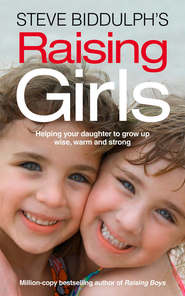По всем вопросам обращайтесь на: info@litportal.ru
(©) 2003-2024.
✖
The Complete Parenting Collection
Автор
Год написания книги
2018
Настройки чтения
Размер шрифта
Высота строк
Поля
Around age thirteen, the reorganisation of Jamie’s brain, linked with the rapid growth of his body, makes him dopey and disorganised for many months. His mother and father have to act as his substitute brain for a while! If they’re not aware of the reasons for this, parents can wonder where they have gone wrong. But if Jamie’s parents know this is all part of puberty, and take a relaxed – if vigilant – attitude, then things should work out just fine.
By age fourteen, the testosterone level is now at a peak, and pubic hair, acne, strong sexual feelings and a general restlessness may well drive Jamie and everyone around him slightly crazy. For most families this is the most challenging year of raising boys – take comfort that if you hang in and stay caring and firm, it does pass. The later teens find boys getting increasingly more sensible and mature.
When Jamie reaches his mid-twenties, things settle down, hormonally speaking. His testosterone levels are just as high, but his body has become used to them and he is not quite so reactive. His erections are a little more under control! The hormone continues to endow him with male features – high cholesterol, baldness, hairy nostrils and so on – well into later life. On the plus side, the testosterone gives him surges of creative energy, a love of competition, and a desire to achieve and to be protective. Hopefully his energies will be channelled into activities and career choices (as well as a happy sex life) which bring all kinds of satisfaction and benefits.
In his early forties, Jamie’s levels of testosterone begin a very gradual decline. He goes for several days at a time without thinking about sex! In the bedroom, quality replaces quantity. In the world, Jamie now has less to prove, and is more mellow and wise. He assumes quiet leadership in group and work situations, rather than having to prove who’s boss. He values friendship and makes his best contributions to the world.
Each boy is different
What we have described here is the pattern for the average boy. There is great variation among males and also lots of overlap between the sexes. Some girls will have more testosterone-type behaviour than some boys, and some boys will show more estrogen-type behaviour than some girls. Nonetheless, the general pattern will hold true for most children.
Understanding boys’ hormones and their effects means we can understand what is going on and be sympathetic and helpful. Just as a good husband understands his partner’s PMT (premenstrual tension), a good parent of a boy understands his TNT (testosterone needing tuition).
PRACTICAL HELP
TEENAGE BOYS AND DRIVING CARS
The biggest single worry for most parents of boys is safety. In the adolescent years, as he spends more time away from your direct care and his mobility and independence grows, it’s hard to relax and just ‘let go’. And in fact there is growing evidence that this fear is well grounded, that we are letting go too soon. This is especially true in the matter of driving cars. Every year the newspapers carry stories of small towns or suburban communities across the nation devastated by multiple fatality crashes, where four or five teenagers die in collisions caused by immaturity and inexperience.
As a community we care deeply about the lives of our young people, and this has prompted some astounding research into why boys die like this and how to prevent it. It has been discovered that one boy on his own driving a car, aged in his late teens, is relatively safe. Today’s emphasis on driver training and 50-100 hours of practice driving with an adult supervising (usually Mum or Dad) means young men have greater awareness and skill than young drivers in our day. They probably drive too fast at times, but are also more focussed on and attentive to their driving, so they do not fare too badly as long as alcohol is not involved. However, if you add a male passenger in the car, things begin to change: the young driver takes more risks, and the chances of a fatal crash increase by 50 percent. If the passenger is a girl, however, a male driver usually becomes protective and careful, and is actually safer than he is on his own.
The next part will shock you. If you now add one or more other young people in the back seat, the death rate of the driver increases by over 400 percent. The distraction, the need to impress, and the difficulty of staying in a calm, careful state of mind, mean that all those in the car are at serious risk. This is especially so after dark, and of course is much worse with drugs or alcohol present. This astonishingly clear research has lead to law reforms that are saving lives around the world. In Australia, a bereaved father, Rob Wells, who lost his son along with three other boys in a single car crash, has campaigned to persuade governments in several states to restrict young drivers carrying more than one passenger, especially late at night. These laws have worked very effectively in New Zealand and Canada for many years.
Meanwhile, it helps that parents know about this ‘brain overload factor’ – the ‘maturity bypass effect’ of having friends in a car – and can make informed decisions. Psychologists now believe seventeen-year-olds are too young to drive groups of friends about at any time. You have ferried them about for sixteen years already; why not do it for another year or two, to know they won’t die or kill their friends? A year or two later, and with more experience, they will be so much safer.
At seventeen, teenagers can sound persuasive. They can say the right things. But it’s later, under pressure, that their brains are not able to cope. The last thing parents of dead teenagers ever hear them say is, ‘I’ll be fine, Mum’.
Why boys scuffle and fight
Testosterone affects mood and energy levels; it’s more than just a growth hormone. There’s no doubt it causes energetic and boisterous behaviour. That’s why, for centuries, horses were gelded to make them better behaved. Testosterone injected into female rats makes them try to mate with other female rats and fight with each other. It makes certain parts of the brain grow and others slow down their growth. It can grow more muscles and less fat, and it can make you go bald and bad tempered!
How testosterone affects the psychology of males can be illustrated by a famous study. A tribe of monkeys in a laboratory was closely observed to learn about its social structure. Researchers found that the male monkeys had a definite hierarchy, or pecking order. The females’ hierarchy was looser and more relaxed, based on who groomed whose hair! But the males always knew who was boss, sub-boss, and sub-sub-boss, and had frequent fights to prove it.
Once the researchers had worked out the monkey dynamics, they set about stirring up trouble. They captured the lowest-ranking male monkey and gave him an injection of testosterone. Then they put him back with the tribe. You can guess what happened next. He started a boxing match with his ‘immediate superior’. Much to his own surprise, he won! So he went and took on the next monkey! Within twenty minutes he had worked his way up to the top and tossed the biggest monkey off the highest branch. Our hero was small, but he had testosterone! He became the ‘acting manager’.
Sadly for him, this was not to last. The injection soon wore off, and our little hero was knocked back all the way down to the bottom of the heap. It’s a lot like politics!
The point is that testosterone influences the brain and makes boys more concerned with rank and competition.
Boys need order
In their book, Raising a Son, Don and Jeanne Elium tell the story of an old scoutmaster who comes and sorts out a hopelessly rowdy scout troop in their city. This is the ‘scout troop from hell’: the boys are always fighting and damaging the hall, nothing is being learnt, and many gentler boys have left. It’s time for a clean sweep. On his first night with the troop, the scoutmaster sets some rules, invites a couple of boys to shape up or leave, brings in a clear structure, and begins teaching skills in an organised way. He successfully turns the group around: in a couple of months it is thriving.
The scoutmaster explained to the Eliums that, in his experience, there are three things boys always need to know:
1. Who’s in charge?
2. What are the rules?
3. Will those rules be fairly applied?
The key word is structure
Boys feel insecure and in danger if there isn’t enough structure in a situation. If no-one is in charge, they begin jostling with each other to establish a pecking order. Their testosterone-driven make-up leads them to want to set up hierarchies, but they can’t always do so because they are all the same age. If we provide structure, then they can relax. For girls, this is not so much of a problem.
Many years ago I spent time in the slums of Calcutta to learn about families there. At first glance, Calcutta seemed chaotic and frightening. In fact, though, there were ganglords and neighbourhood hierarchies – and these, for better or worse, provided a structure for people to live their lives. You were safer with a structure – even a mafialike structure – than with none. As a better structure was provided by religious or community leaders who were trustworthy and competent, life improved. Wherever you see a gang of boys looking unruly, you know the adult leadership is failing. Boys form gangs for survival – it’s their attempt to have a sense of belonging, order and safety.
Boys act tough to cover up their fear. If someone is clearly the boss, they relax. But the boss must not be erratic or punitive. If the person in charge is a bully, the boys’ stress levels rise and it’s back to the law of the jungle. If the teacher, scoutmaster or parent is kind and fair (as well as being strict), then boys will drop their ‘macho’ act and get on with learning.
This seems to be an in-built gender difference. If girls are anxious in a group setting they tend to cower and be quiet, whereas boys respond by running about and making a lot of noise. This has been mistakenly seen as boys ‘dominating the space’ in preschools, and so on. However, it is actually an anxiety response. Schools which are very good at engaging boys in interesting and concrete activities (such as Montessori schools, where there is a lot of structural work with blocks, shapes, beads and so on) do not experience this gender difference in children’s behaviour.
Not everyone accepts that hormones affect boys’ behaviour. Some feminist biologists have argued that men have testosterone through conditioning – that it comes from being raised that way. There is actually a partial truth in this: one study found that boys in scary or violent school environments produced more testosterone. When the same school introduced a more supportive environment – where teachers did not abuse or threaten, where bullying was tackled with special programs – the boys’ levels of testosterone dropped measurably. So environment and biology both play a part, but environment only influences the hormone. Nature – and boys’ inbuilt calendar – creates it. Success with boys means accepting their nature while directing it in good ways. If you know what you are dealing with, it’s a whole lot easier and you don’t need to blame anyone – just help them find a better way.
PRACTICAL HELP
AMAZING TESTOSTERONE FACTS
In the animal kingdom, one kind of hyena – the spotted hyena – is born with so much testosterone that even the female pups have a pseudo penis and their labia resemble testicles. The pups are born with a full set of teeth, and are so aggressive that they often eat each other within a day or two of being born!
In a rare condition of boy babies, which is found in the Dominican Republic, testosterone does not take effect in the womb because of a missing enzyme. These boys are born without a penis or testicles – looking in fact more like girls, and raised as such. But at about twelve years of age, testosterone is produced in their body and the boys suddenly develop into ‘real’ boys, growing a penis and testicles, getting a deep voice, and so on. They apparently then live normal lives as men. They are known as ‘penis at twelve’ children.
A condition called Congenital Adrenal Hyperplasia can give girls excess testosterone in the womb, but this is remedied once the child is born. Although they are hormonally normal from then on, these girls show above-average athletic skills, as well as a preference for male playmates, toy cars and guns, and ‘masculine’ clothes.
An excess sensitivity to testosterone, or an excess of it, has been linked significantly to mathematical ability, left-handedness and a very high incidence of asthma and allergies.
Estrogen – the female counterbalancing hormone to testosterone – has been shown to cause nerve cells to grow more connections. Females have smaller brains, but these are better connected!
Baritone singers in Welsh choirs have more testosterone than tenor singers. Baritones are also more sexually active!
Making love raises your testosterone level. The more you get, the more you want – at least for a couple of days! Winning at sport or politics also raises your testosterone level. Stress and loneliness lower it: they lead to more estrogen being produced so you can cope like a woman!
One final testosterone fact – perhaps the most amazing of all – illustrates the intricate dance between biology and behaviour in the development of higher animals. Are you ready? Here goes …
Mother rats frequently lick the genitals of their male babies, and this helps the latter’s brains to become fully male. And guess what? It’s the presence of testosterone in the urine of the baby male rats that seems to trigger the behaviour. If baby female rats are given testosterone injections, the mother licks their genitals, too! If baby boy rats are castrated, the mothers don’t lick them any more (a double tragedy!).
But wait, it gets more amazing. The rats that are licked in this way develop a masculine-functioning pituitary gland, whether they are male or female. Female rats given the licking treatment behaved like male rats for the rest of their lives. And when the licking was replaced by a researcher stroking the male or female rats with a paintbrush each day, the same long-term physical changes to the brain took place.
Of the hundreds of studies I have seen, this one probably tells us more about how complex the interaction is between nature and nurture in developing gender characteristics. (And that is perhaps the only conclusion we can draw from it!)
There are physical and social influences at work all the time, in complex interaction, to produce healthy and functioning males and females. Gender differentiation does not just happen automatically. Without affection and stimulation, we know children don’t grow as well or become as intelligent as their potential would allow. We have to bring nurturing and parenting skills to bear, to help our kids both develop physically and find a comfortable gender identity.
How did male and female differences come about?
Evolution is constantly changing the shape of all living creatures. For instance, early humans had huge jaws and teeth for chewing raw food. But when fires and cooking were discovered, over many generations our jaws and teeth became smaller because our food was softer to chew. If we have a few thousand years of eating fast food, we may end up chinless altogether!
Some gender differences are obvious in human beings – size, hairiness, and so on. But the main differences are the hidden ones. These came about through taking very different roles for a very large part of our history. Hunter-gatherer societies divided the work very much along gender lines. For 99 percent of human history, the women mostly gathered, and the men mostly hunted.
Hunting was a specialised activity. It required quick team action, sudden and strong muscular activity in short bursts, and you had to be very single-minded. Once the chase was on, there was no time for discussion. Someone was in charge, and you did what you were told – or got gored or eaten by a large animal.











